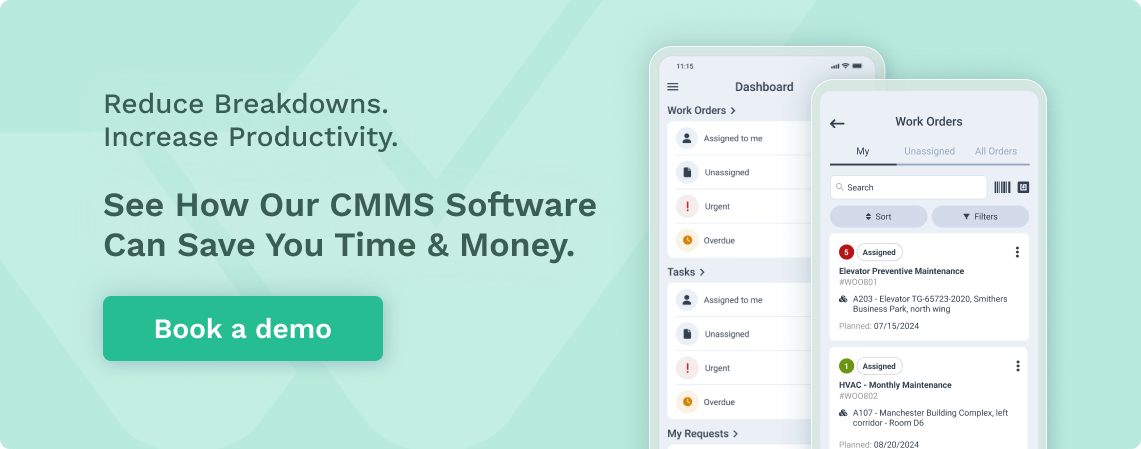Get a Free WorkTrek Demo
Let's show you how WorkTrek can help you optimize your maintenance operation.
Try for freeA business that works perfectly is a business organized from A to Z. And optimized inventory management plays a key role in this organization. Perfectly controlled inventory management makes it possible to cope with sales peaks, especially during commercial operations. But in addition to saving you money, inventories can save you money: goodbye to goods that end up perishing and dead stocks!
Read also 10 Easy Steps To Successful CMMS Implementation
What is Inventory Management?
Inventory management consists of keeping track of the goods stored by your company and controlling their weight, dimensions, quantities, and location. The goal of inventory management is to minimize the cost of holding merchandise by helping you know when it’s time to restock products or repurchase your raw material to manufacture them.
As for inventory control, which closely resembles inventory management, it specifically refers to when you control your inventory, usually through effective management tools or methods. It’s much easier to maintain control of your inventory with centralized management.

Why is inventory management important?
Effective inventory management is essential to ensure that a business has sufficient merchandise to meet customer demand. If inventory management is not properly managed, the business can either lose money on potential sales that cannot be realized or waste money by storing too much product unnecessarily.
Inventory management can serve you in several other ways:
1. Avoid waste – If you sell products that have an expiration date (like food or beauty products, for example), you will run into difficulties if you fail to sell your merchandise on time. Optimized inventory management will allow you to prevent your products from going out of date.
2. Avoid deadstock – A deadstock can no longer be sold, but for reasons other than the expiry of the products. It could be that your products are out of fashion, not suitable for the coming seasons, or simply obsolete. By effectively managing your inventory, you can avoid this problem.
3. Save storage costs – Storage costs are variable costs, which means that they evolve according to the number of products stored. If you keep too many products in stock or fail to sell certain items, your storage costs will increase…
4. Improve cash flow – Proper inventory management not only saves you money but also optimizes cash flow in a number of ways. As mentioned before, you’ve probably spent some money acquiring your stock, and you’re going to resell it for a profit. But, until you resell it, your stock costs you more money than it earns you.
That’s why it’s important to consider inventory as part of your cash flow management. Inventory affects both sales enablement and expenses since you rely on it to know how much product you can sell and need to order. This therefore significantly influences the amount of available cash. In short, good inventory management allows for better cash flow management.
A good inventory management system will allow you to know exactly the quantity of products you have and, based on sales, you will be able to make projections in order to know when you will have to reorder certain items. You will avoid losing sales and you will have enough cash available to better plan your future orders.

The different types of inventory
Now that you know what inventory management is, let’s review the types of inventory you’ll be dealing with:
- Raw materials,
- Products in process,
- finished products,
- Maintenance, repair, and operating goods.
Raw materials – Raw materials are materials or substances used at the start of the production or manufacture of goods. We think in particular of wood, metals, plastics, or fabrics used in the creation of finished products. A business owner or manufacturer acquires these materials from one or more suppliers or producers.
Products in progress – Work-in-progress products are unfinished products that can only be sold after processing by your company.
In a balance sheet, finished goods include all production costs: labor, machinery, raw materials, and other equipment. At this stage, its value is only that of the materials, time, and labor invested.
Finished products – Finished goods inventory is the number of in-stock products available to customers. Once a work in process is processed and finished, then it becomes part of the finished goods inventory.

Finished goods are subject to a markup, which means that the price at which they are sold is higher than what the items cost you.
Maintenance, repair, and operating products – Here we refer to the materials and various equipment used in the production process, but which are not, however, part of the final product.
Read also 6 steps to implement the work order process.
Here are some examples of maintenance, repair, and operation products:
- Personal protective equipment like face masks, gloves, and safety glasses,
- Cleaning supplies like sanitizers, brooms, and buckets,
- Office supplies like notebooks, pens, and tape
- Technical equipment such as laptops, printers, scanners, etc.
- Laboratory equipment for any test and any research aimed at creating products,
- Repair tools.
Inventory Management Techniques
How to manage inventory varies with each business. However, all contractors should do their best to try to eliminate the risk of human error from the inventory management process. This means that it is best to use inventory management software.
Establish a minimum stock level
Simplify your inventory management process by establishing, for each of your products, a minimum stock level. In concrete terms, this consists of holding only the minimum quantity of products necessary for the proper functioning of your business, at all times. When the quantity of a product drops below the predefined quantity, the replenishment order must then be placed.
Calculate your order point
The reorder point tells you the level at which it’s time to restock. Once you know your safety stock level, you can consider your supply chain lead time to determine the best time to place your order.
Perfectly manage your relationships with your suppliers
The ability to adapt quickly is essential to effective inventory management. Whether it’s returning a slow-selling product to replace it with a new item, quickly recommending a high-selling product, fixing issues with the manufacture of goods, or temporarily increasing your storage; it is important to maintain a good relationship with your suppliers. Thus, they will naturally be more understanding and accommodating in the event of a problem.
Maintaining good relationships with your suppliers will provide you with other benefits, especially when negotiating minimum order quantities. Don’t be afraid to negotiate lower minimum quantities so you don’t have to carry too much stock.
Maintaining a good customer-supplier relationship is not only about being friendly, it is also about being professional. You need to let your suppliers know when you expect sales to increase so they can ramp up production as soon as possible. If you can’t sell a product, discuss it with them; this will allow you to pause your promotions or seek an interim substitute.
Also, keep in mind that a bad supplier can very quickly create big problems in your business. If they are consistently late with their deliveries or send the wrong amount of items, it can disrupt your operations. A supplier audit is an opportunity to identify areas for improvement and determine when to stop them.

Have an emergency plan
Poor inventory management can lead to a few problems, here are the most common ones you may face:
- You find yourself in a budget deficit and do not have enough budget to order a product you really need,
- Your warehouse does not have the space necessary to store your goods,
- A poor estimate of your inventory levels affects your sales projections,
- Your supplier stops manufacturing a product without notice.
It is therefore important to be able to predict when a problem could arise. Identify risky activities and develop a contingency plan. How are you going to react? What steps are you going to take to solve the problem? How will this impact other aspects of your business? Remember that a well-maintained customer-supplier relationship can have a significant positive impact on your ability to deal effectively with the unexpected.
Do frequent inventory checks
It is essential to regularly perform reconciliation operations between your actual and theoretical inventory quantity. To do this, there are several methods:
- Physical inventory – Carrying out a physical inventory means counting all your products at once. Several merchants carry out a physical inventory at the end of the year; since they prepare their accounts and the payment of income taxes at the same time. Although physical inventories are usually only done once a year, they can be laborious, especially if you find a discrepancy, as finding out the cause can be a complex task.
- Spot checks – If you are used to taking a full physical inventory at the end of the year, and often have problems or have a lot of product in stock, you should start doing spot checks during the year. It would be like comparing the actual quantity of a given product to what you would normally have. You can perform these checks at any time. However, we recommend that you perform these spot checks in addition to physical inventory and not as a substitute. When doing spot checks, focus especially on products that sell out very quickly or that often cause problems.
- The rotating inventory – Instead of counting all the products at the same time during a physical inventory carried out at the end of the year, the rotating inventory makes it possible to spread the reconciliation operations throughout the year. Every day, every week or every month, check a different product. There are several methods to identify the items that should be counted first, but in general, it is the high-value items that are counted most frequently.

Use ABC analysis
Some products require more attention than others. Use the essential ABC analysis to determine your priorities for managing your inventory. Separate the products that sell the most and those that sell the least. To do this, you can assign each item on your product listing to one of these three categories:
A = % of the stock that represents 80% of your income

B = % of inventory that represents 15% of your revenue
C = % of the stock that represents 5% of your revenue
As you will have understood, your stock A represents your most profitable and valuable products. Make sure you always have them on hand so you don’t miss out on sales. Your C stock is your slow-moving or dead stock. This is a stock that you can offer at a reduced price as part of a promotional operation, in order to be able to offload it.
Think about a safety stock
Safety stock is like an emergency fund. It is actually a stock that you “set aside” to use in an emergency. It is more concretely a threshold from which you must reorder goods before drawing on your emergency stock reserve.
Here is an example of a safety stock formula for some industries:
Safety Stock = (Max Daily Usage x Max Lead Time) – (Average Daily Usage x Average Lead Time)
It’s a good idea to incorporate safety stock into your inventory management strategy in case your supply chain is disrupted, your goods are damaged, or something else prevents you from receiving or handling goods.
Update stock cards in real time
Maintain product information for all items in your inventory. Access to regularly updated and correct data is essential to move products quickly and efficiently. Remember to record information such as barcodes, suppliers, lot numbers, and the dates of the last transactions.
Entrust inventory management to a single person
If your business continues to grow and inventory management starts to become too complex, it might make sense to assign the role of inventory manager to one person. His role will thus be to monitor all products and be in charge of managing restocking, negotiating with suppliers, and paying invoices.
Read also 10 steps for choosing the right CMMS.
Conclusion
Remember that with an effective inventory management tool, you can help reduce your costs, maintain the profitability of your business, analyze sales trends, and forecast future sales but also prepare for the unexpected.. With good inventory management, a business has a better chance of profitability and survival.
Then it’s time for you to take control of your inventory management! Choose the right inventory management techniques and tools and start implementing them today.











